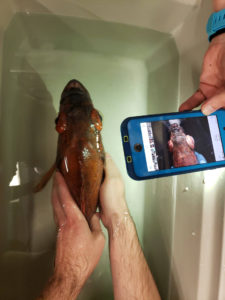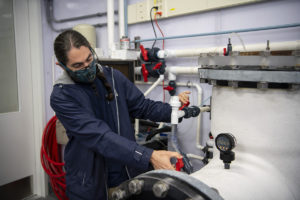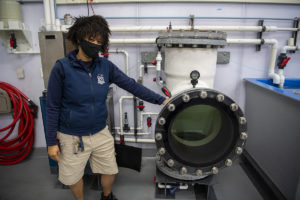Aquarist John Foster cradled the vermilion rockfish gently in two hands, submersed. Anesthetized, it lay still as veterinarian Dr. Kadie Anderson took a quick documentary photo of its eyes, which bulged to each side. Then Foster lowered the fish – now fully awake – into a water-filled container that looked something like sci-fi author Jules Verne might have invented, and bolted the lid securely.
Rockfish recompression was about to commence at Point Defiance Zoo & Aquarium.
“Some of our rockfish have had problems with gas build-up behind their eyeballs,” explains Dr. Anderson. “The historical treatment has been to remove the gas with an injection needle, which is not ideal. It takes months to see resolution, and requires frequent exams and treatments. Putting them in a recompression chamber resolves their problems in a couple of weeks. It’s really amazing to be able to give fish that level of care so quickly and non-invasively.”
What’s also amazing, though, is that Zoo staff built the recompression chamber themselves – with a little help from their friends.
Fish get sick too

Hyperbaric (or recompression) chambers, of course, are not a new invention. Humans regularly need them, occasionally for scuba diving incidents where a diver has had to resurface too fast. Breathing compressed air, divers build up higher than normal levels of nitrogen at depth, which gets stored in the bloodstream. Lowering the surrounding water pressure too quickly – say, surfacing from 100 feet to the surface in under a minute – causes that nitrogen to escape into their bodies in the form of gas bubbles. If they can’t exhale it in time, it gets trapped in tissues and joints.
The resulting decompression sickness (aka “the bends”) can be incredibly painful, sometimes fatal, and needs immediate treatment in a hyperbaric chamber, which simulates higher pressure to reabsorb the bubbles. The pressure is then slowly lowered to allow the gas to escape safely through exhalation.
Fish are usually much better than humans at safely navigating water depth. But sometimes they get gas buildup, confirmed via ultrasound – and when it does, it’s just as painful.
“Fish are better at removing oxygen, but the nitrogen often gets trapped behind their eyes or in their gills,” Dr. Anderson explains.
And that’s where you need a fish recompression chamber.
30,000 Leagues Under the Aquarium

“Monterrey Bay Aquarium pioneered these chambers for use with fish,” says Foster, one of the aquarists at Point Defiance Zoo & Aquarium who helps care for the rockfish. “They loaned us a small one in 2019, which we used on a tropical fish. It worked amazingly well.”
So, with Monterrey Bay’s assistance, the Point Defiance Zoo staff built their own. Truly a team effort, it involved aquarium aide Chris Spaulding, plumber Jack Hunter and life support specialist Doug Immerman, with expert guidance from aquarists and electricians.
The result is impressive, even just to look at. A round chamber about three feet high, with a porthole in front and serious-looking bolts all around, it sprouts a series of thick PVC pipes that can withstand water pressure up to 120 psi. These connect variously to freshwater intake, a heater, filter, oxygenator and outflow systems, just like any aquarium. There’s a special feeding tube with lock-off valves on either side, which aquarists can open up at feeding time without disturbing the pressure in the main chamber. And of course, there’s the main pressure valve to mimic surface or deep water.
The whole thing looks like something out of a Jules Verne science fiction novel, mysterious and scientific and oceanic. Only a handful of aquariums around the country have them. And, staff believe, the one at Point Defiance Zoo may just be the biggest in operation.
Good for fish, good for their care team

Even better, the fish seem quite comfortable in there.
“During his two-week treatment the vermilion rockfish explored the whole system,” says aquarium assistant Tai Fripp. “He would end up facing the porthole, and it was fun to arrive in the morning and see him staring at you. It also allowed us to observe both of his eyes, multiple times a day.”
“This treatment is much less stressful for the fish,” adds aquarist Mikiko Williams. “If we need to, we can easily increase the pressure again and give the fish more time to heal.”
All the aquarists are divers, and Williams has experienced a hyperbaric chamber herself, about eight years ago. Caught in a sudden swell, she’d been pushed up in an uncontrolled ascent from 60 feet (usually divers have a protocol of spending certain amounts of time at intervals as they surface).
“I had this weird pain in my knee, and was afraid it was decompression sickness,” says Williams, who then underwent treatment. “I sat in that chamber for five hours with an oxygen cap on my head.”
Other rockfish have gone through the recompression chamber as well, including a black rockfish with acute gas problems that took just 30 minutes in the chamber to show improvement.
“They responded very well to treatment and seem to feel a lot better,” said Dr. Anderson.
Rockfish comes home
As Williams makes the rounds to check on her charges, she stops at the top of the big Northwest Waters habitat in the Pacific Seas Aquarium. The vermilion rockfish is there instantly, hanging out near the surface and staring up with eyes that look perfectly, beautifully normal.
“We’re all so happy to have this chamber,” says Williams, and smiles down at the rockfish.